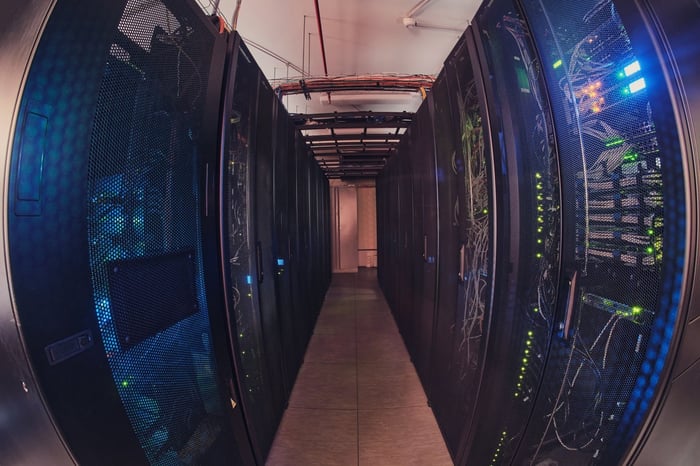|
|
|

|
|||||

|
|
Blackwell architecture is driving accelerated revenue growth beyond Wall Street expectations.
Export restrictions have paradoxically strengthened Nvidia's position with higher-margin U.S. customers.
Nvidia’s post-earnings pullback offers a compelling entry point into one of the most important companies on the planet.
Nvidia (NASDAQ: NVDA) shares fell roughly 2% following its fiscal 2026 second-quarter earnings release on Wednesday despite delivering revenue of $46.7 billion that beat guidance of $45 billion and issuing Q3 guidance of $54 billion.
Wall Street's muted reaction reflects unrealistic expectations for a company that has consistently outperformed. However, this pessimism creates an opportunity for investors who understand the bigger picture unfolding across the artificial intelligence (AI) landscape.
Where to invest $1,000 right now? Our analyst team just revealed what they believe are the 10 best stocks to buy right now. Continue »

Image source: Getty Images.
Nvidia reported fiscal Q2 revenue of $46.7 billion, up 56% year over year, beating guidance of $45 billion. Q3 guidance of $54 billion represents 54% year-over-year growth. These figures exclude any H20 product revenue from China, yet growth remains robust.
The company's data center business continues driving growth. Underscoring this point, revenue from the new Blackwell products came in at a staggering $11 billion in fiscal Q4 2025, exceeding management expectations and signaling stronger-than-anticipated demand for next-generation AI infrastructure.
Wall Street thinks the China restrictions hurt Nvidia, but they've actually created opportunities with leading U.S. cloud customers. The new Blackwell rollout and strong demand from domestic hyperscalers reduce geopolitical risk while maintaining robust growth. Leading U.S. cloud customers have absorbed capacity that would have gone to China, often improving the company's customer-quality mix.
This geographic shift has actually improved Nvidia's customer quality. Instead of dealing with geopolitically sensitive Chinese buyers, the company now focuses on cash-rich American hyperscalers with multiyear AI infrastructure commitments worth hundreds of billions of dollars.
Nvidia's true competitive advantage isn't its hardware -- it's the Compute Unified Device Architecture (CUDA) software ecosystem that underpins most leading AI models and creates significant switching costs. Models like OpenAI's GPT series and Meta's Llama architecture were built using CUDA tools and frameworks.
This creates massive switching costs for any organization that has invested years in training engineers on CUDA development. Even if competitors like Advanced Micro Devices developed comparable chips tomorrow, migrating existing AI models would require months of engineering work and risk introducing performance degradations.
The company has systematically expanded this moat through strategic acquisitions, such as the $6.9 billion purchase of Mellanox Technologies in 2020. This networking expertise allows Nvidia to offer complete rack-scale solutions rather than individual components, making it even harder for customers to mix and match alternatives.
Consider the economics: When Tesla trains its Full Self-Driving neural networks or when OpenAI develops new language models, they're not just buying Nvidia chips -- they're buying into an entire development ecosystem. Switching would mean retraining thousands of engineers and potentially rebuilding years of AI development work.
The real catalyst lies in Nvidia's next-generation Blackwell architecture, which processes AI workloads with dramatically improved efficiency, while commanding higher prices. Conservative models put data center revenue near $257 billion by fiscal 2027, a roughly 41% compound annual growth rate, representing substantial growth from current levels.
Each gigawatt-sized data center represents approximately a $50 billion infrastructure opportunity, and Nvidia has captured about one-third of cumulative data center capital expenditures to date. With dozens of these facilities planned across the globe, the addressable market continues expanding.
The company's gross margins tell the story of pricing power. Margins are forecast to dip temporarily as Blackwell ramps, then recover to the mid-70% range exiting fiscal 2026 -- levels that would make most software companies envious.
Nvidia is developing the infrastructure backbone of the AI revolution. This comprehensive approach means customers aren't just buying chips -- they're investing in a platform that reduces development time and maximizes performance.
As a result, this 2% post-earnings decline scans as an attractive entry point for investors seeking exposure to the AI revolution. After all, Nvidia continues delivering outsized growth while building an increasingly unassailable moat around the most important technological innovation in human history.
Before you buy stock in Nvidia, consider this:
The Motley Fool Stock Advisor analyst team just identified what they believe are the 10 best stocks for investors to buy now… and Nvidia wasn’t one of them. The 10 stocks that made the cut could produce monster returns in the coming years.
Consider when Netflix made this list on December 17, 2004... if you invested $1,000 at the time of our recommendation, you’d have $659,823!* Or when Nvidia made this list on April 15, 2005... if you invested $1,000 at the time of our recommendation, you’d have $1,113,120!*
Now, it’s worth noting Stock Advisor’s total average return is 1,068% — a market-crushing outperformance compared to 185% for the S&P 500. Don’t miss out on the latest top 10 list, available when you join Stock Advisor.
*Stock Advisor returns as of August 25, 2025
George Budwell has positions in Nvidia. The Motley Fool has positions in and recommends Advanced Micro Devices, Meta Platforms, Nvidia, and Tesla. The Motley Fool has a disclosure policy.
| 28 min | |
| 45 min | |
| 2 hours | |
| 2 hours | |
| 2 hours | |
| 3 hours | |
| 4 hours | |
| 5 hours | |
| 5 hours | |
| 5 hours | |
| 5 hours | |
| 5 hours | |
| 6 hours | |
| Nov-08 | |
| Nov-08 |
Join thousands of traders who make more informed decisions with our premium features. Real-time quotes, advanced visualizations, backtesting, and much more.
Learn more about FINVIZ*Elite